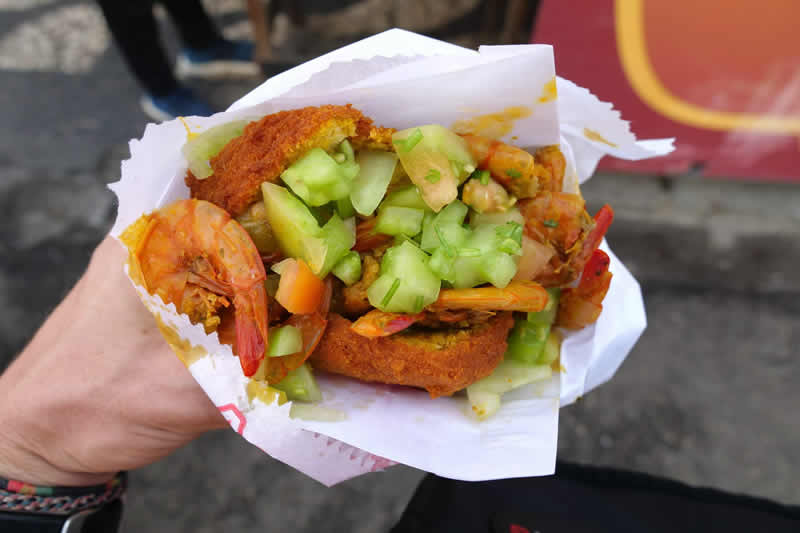Food festival celebrates Acarajé a traditional Afro-Brazilian street food
- Home
- Food festival celebrates Acarajé a traditional Afro-Brazilian street food

Food festival celebrates Acarajé a traditional Afro-Brazilian street food
Here at Rio de Janeiro’s Praca Maua, crowds have started arriving for the largest ever outdoor acarajé festival.
Originating in Bahia, acarajé is made by baianas – woman from Bahia who are descendants of slaves. The fried bun has its roots in West Africa and was brought to Bahia in the 19th century. Until relatively recently, the dish could only be found in Bahia, but lately, the culture, food and traditions of baianas is growing in popularity in cities across the country. Acarajé is made using black eyed beans as the main ingredient. The batter is shaped using wooden and metal spoons and placed in palm oil.
Once hardened and crispy, the buns are cut in half and filled with various ingredients. The main one is vatapá, also of African origin, accompanied by dried shrimp. For many, the Baiana de Acarajé festival – now in it’s second year – was a first chance to try acarajé.
Ita Yani a tourist from Japan gives it the seal of approval.
“Tasty!” she says.
Many of these women follow the traditions of the orixas, or African deities.
Acarajé originated as a religious food, offered during rituals.
Maura do Acarajé proudly displays an image of Iansã who is the orixa related to this kind of food.
“Iansã, Oiá, known as Oiá or Iansã or Santa Barbara, this is my Iansã, my queen,” says Maura.
“This is the happiest day in my life. It’s the second Acarajé festival but now baianas have full rights. Back then we had no rights. We went into the streets no knowing if we could return home with our merchandise, because everything was confiscated. So for me it was very sad. I suffered a lot, but I suffered and survived,” says Maura do Acarajé.
Previously the women were not allowed to sell acarajé without permits in Rio, but new city regulations now allow them to set up stalls almost anywhere, at any time of day.
At the festival, another version of acarajé cut in small pieces and served on a platter is also popular. Okra paste and tomato salad can be added to the regular vatapá and dried shrimp.
For the women who make and sell acarajé, the festival is a chance to celebrate their Afro-Brazilian culture.
Rio resident Rafael Souza and his friends love the crispy bun.
“It’s the Brazilian seasoning, the flavour of Brazil,” he says.
Carlos Suzarte came with his family. His wife is from Bahia. He never misses a chance to have acarajé when the quality is good.
“It’s a mixture of flavours, an explosion of flavour. A mixture of many flavours that together become marvellous. It’s delicious” says Carlos.
Tania Baiana explains some of acarajés secrets:
“The batter is made from black eyed peas, blended with onions. The greatest secret of a baiana is in the batter. The more you mix it and blend it, the tastier it becomes” said Tania.
The ever present ingredient is this red oil from the African dendê palm tree.
“This is dendê oil. This oil makes our acarajé as a fire bun. It makes it crispy so that when you bite, you can feel the flavour,” says Tania Baiana.
“Vatapá is made from bread plus ginger, onions, brazil nuts, peanuts, coconut milk and dendê oil. Then we have the dried shrimp to use as filling,” says Nice Gomes – a member of the committee in charge of keeping the traditions of the baiana.
For the women, the making and selling of acarajé is a cultural tradition that must be protected.
“Here in the state of Rio, there are many baianas, at least 40 and Iphan has the responsibility to conduct the safeguarding process,” says Leticia Ribeiro of Brazil’s Heritage Institute – Iphan.
“Whenever an asset is registered as intangible cultural heritage, the state, society and the holders themselves are responsible for keeping the value of the asset and maintaining the craft, such as the clothing and the process of producing the acarajé,” she adds.
For the last 10 years, Rio’s acarajé baianas have been commemorating a special day dedicated to their cultural heritage here at Santa Rita church.
The mass is led by a priest from the state of Bahia.
Ahead of the mass, the women make sure their attire is just right.
“The Acarajé baiana is an intangible cultural heritage and she must wear the costumes which are: this skirt, and an under skirt, the shirt, the pano da costa, and this headdress which we call a turban, which I’m fixing” explains Nice Gomes, a member of the committee safeguarding the baiana culture and acarajé craft.
The mass is followed by a public party at a square in front of the church.
This square is also the location of an old slave cemetery.
Here African religious traditions and Christianity mix without issue, as is traditionally customary in many parts of Brazil.
“It’s the recognition of much work that was done in the historical context of slavery. Courageous women who were able to change their fate thanks to acarajé. Their children graduated, they raised grandchildren with the money they made form selling their product” says Father Marcelo Nascimento, who conducted the mass.
All day long, Rio’s baianas celebrate in St. Rita square.
Passers-by are allowed to taste acarajé for free – only today and every other 25 November.
“During the festival many people tried acarajé for the first time. The acceptance of acarajé has improved because we have explained what acarajé is and so, when people try it, they end up loving it,” says Rosa Perdigão, who coordinates the local Association of acarajé baianas.
The jubilation continues throughout the day, showing the spirit these women bring to the city.
Source: africanews.com
- Share
Classic Ghana
Classic Ghana brings you into a fun world of arts, entertainment, fashion, beauty, photography, culture and all things in between. Let’s explore these together!







